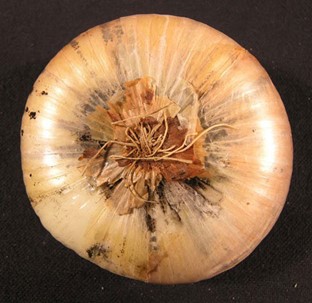Arkansas Plant Health Clinic Disease Notes
Contact
Plant Diagnostician
Phone: (479) 575-2727
Email: ssmith@uada.edu
Jason Pavel
Diagnostician
Phone: (479) 575-7257
Email: jpavel@uada.edu
University of Arkansas System Division of Agriculture
Cralley Warren Building
Room 16
2601 N. Young Ave.
Fayetteville, AR 72704
Onion Black Mold
Sherrie Smith and Jason Pavel
Plant Health Clinic Disease Note Issue 14

Black Mold, caused by Aspergillus niger, is a common problem on onions during transit or storage.
Symptoms are a black discoloration on the neck, shallow black lesions on the outer scales, and streaks of black underneath the outer scales. In extreme cases, the entire surface of the bulb turns black and shrivels. Infection usually starts in the neck, the fungus gaining entry through wounds as the tops break over or are cut at maturity. Infection may also occur through infected onion seed. Occasionally, there are no outward symptoms, but when a bulb is sliced in two, a black or gray discoloration is seen in the center areas of the bulb, usually extending from the neck to the center. Opportunistic bacteria will sometimes follow Black Mold infections causing a soft rot.
How do I prevent onion black mold?
Careful handling of bulbs to avoid bruising when harvesting, transporting, or storing, greatly reduces infection. Existing Black mold will not spread if onions are stored at 34°F to 59°F.

Take Aways:
- Avoid bruising when harvesting or handling.
- Store at 34°F to 59°F.
This work is supported by the Crop Protection and Pest Management Program [grant no. 2017-70006- 27279/project accession no. 1013890] from the USDA National Institute of Food and Agriculture.
Follow us on Facebook!
UAEX Plant Health Clinic